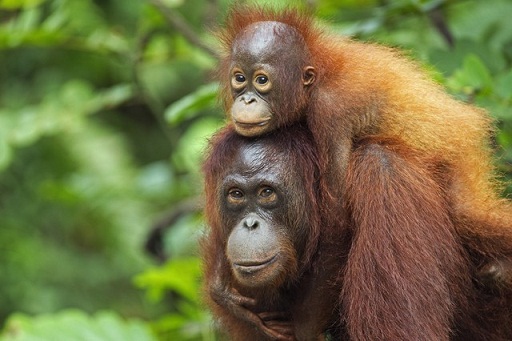The world on Saturday, August 19, 2017 observed the International Orangutan Day with events organised globally to raise awareness about the plight of the now critically endangered primate, whose DNA is said to be 97% the same as humans.

The Rainforest Action Network (RAN), for instance, spoke up for orangutans and against forest destruction.
In a campaign focused on a major orangutan stronghold in Indonesia, the not-for-profit group claims that millions of acres of rainforest in the Southeast Asian nation are destroyed each year for the production of Conflict Palm Oil.
“Snack food giant PepsiCo uses an immense amount of Conflict Palm Oil and is driving this destruction. As more and more of its forest habitat are lost, the orangutan is being driven closer to extinction in the wild,” RAN insists, saying that stopping the destruction caused by PepsiCo will go a long in saving the orangutan.
The group adds: “We have convinced more than a dozen of the world’s biggest snack food corporations to adopt responsible palm oil sourcing policies that ensure the palm oil they use is not destroying the orangutan’s home. Today, we demand that PepsiCo cleans up its supply chain by putting an end to the use of Conflict Palm Oil in its products. When orangutans are gone, they’re gone forever. We must fight for the orangutan!”
In 2016, the International Union for Conservation of Nature (IUCN) changed the classification of the Bornean orangutan (Pongo pygmaeus) from endangered to critically endangered, citing the main causes of its population decline as habitat loss and fragmentation, primarily for logging and oil palm plantations, along with illegal hunting and fires.
The Sumatran orangutan (Pongo abelii) is also listed as critically endangered. There are now only about 14,600 left in the wild.
These are estimated to be between 55,000 and 62,000 Bornean orangutans living in the wild, split into three distinct subspecies.
The IUCN says the population trend is a decrease for both species.
Orangutans’ solitary nature and slow reproductive rates leave them particularly vulnerable when there is forest loss. The rate of population decline is such that it is difficult for the populations to recover because of the lengthy birth intervals.
In findings published in Nature Research’s Scientific Reports in July 2017, a group of researchers concluded that Bornean orangutan populations had declined by 25 percent over the past decade.
The researchers estimated that the overall density of orangutans on the island of Borneo from 1997 to 2002 was about 15 individuals per 100 square kilometres. The density was reduced to 10 individuals per 100 square kilometres in 2009–2015.
“Survival rates of the species are lowest in areas with intermediate rainfall, where complex interrelations between soil fertility, agricultural productivity, and human settlement patterns influence persistence,” the researchers concluded.
The researchers said their study highlighted the urgency of determining specific management interventions needed in different locations to counter the trend of population decline.
The scientists point to the difficulty of accurately assessing the rate of population decline.
“Over the years, different estimates of population sizes have been proposed by various authors, leading to confusion about the conservation status of the species.”
The rate of decline and the drivers of the population change of orangutans are difficult to assess because of the species’ cryptic behaviour, and because surveys of orangutans are typically restricted to small geographic areas, are conducted over short time periods and employ different survey protocols, the researchers say.
The executive director of the UK-based charity, the Orangutan land Trust (OLT), Michelle Desilets, says she would prefer not to get caught up trying to give current population figures.
The OLT spearheads the PONGO (Palm Oil and NGO) Alliance, which was formed in 2015 and aims to protect orangutan habitat in an oil palm landscape.
Desilets points out that 10,000 orangutans are living in areas that have been identified for industrial oil palm cultivation in Borneo. “There is an urgent need for collaborative innovation to protect these animals in mixed-use landscapes.”
There is a genuine commitment from major growers in the PONGO Alliance, Desilets says. “And the alliance has brought together experts and orangutan conservation organisations, who are developing new strategies for the protection of orangutans in legally unprotected areas. All this is quite a positive shift.”
